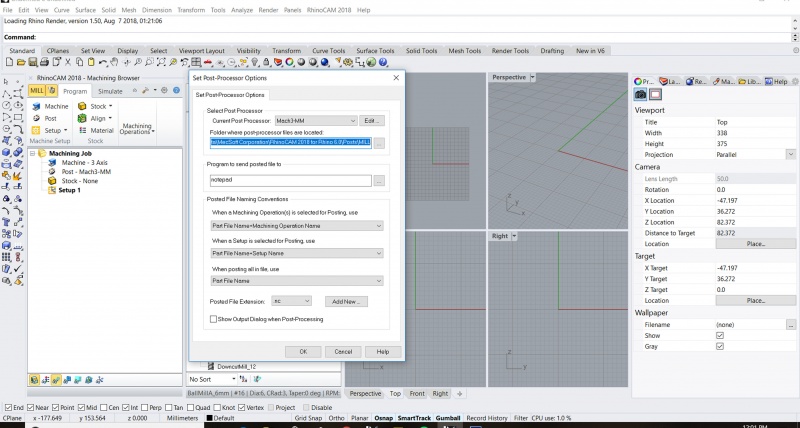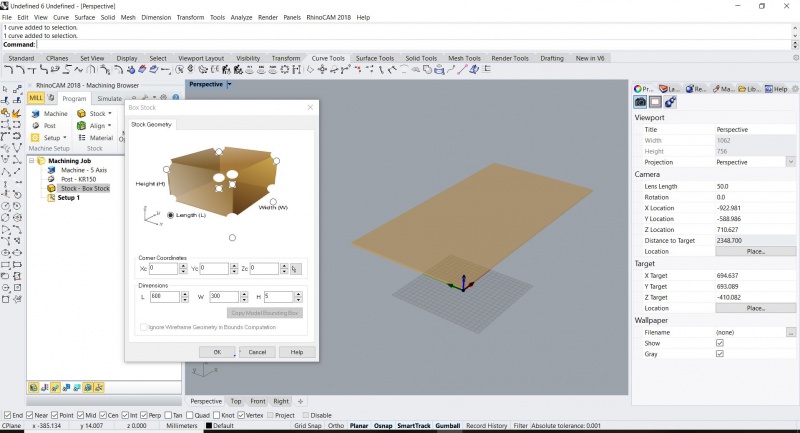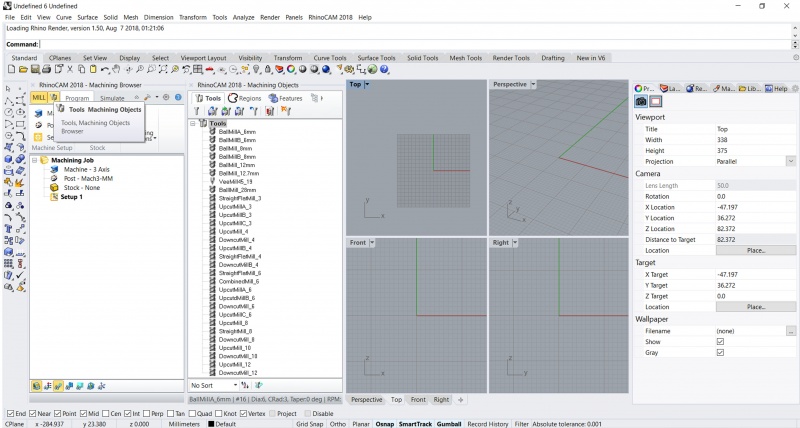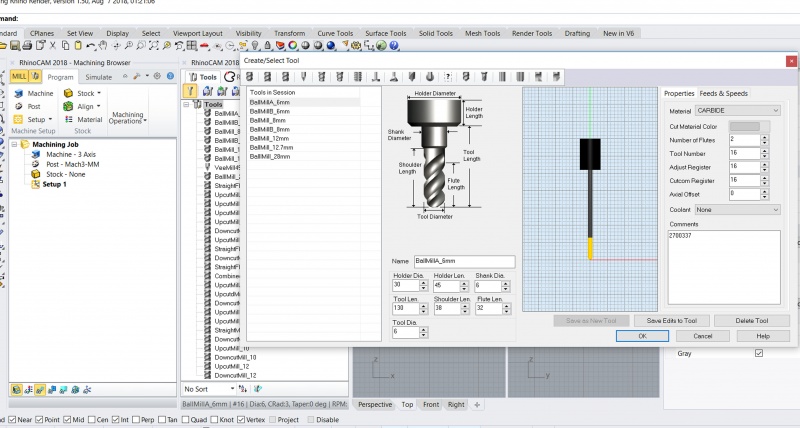3D PRINTING WITH ROBOTS
Contents
Material Preparation
- Locate the Rhinoceros 5 or Rhinoceros 6 shortcut on your desktop and double-click to launch the application.
Alternatively, you can also click on the Windows Start button and select All Programs. Go to the program group containing Rhinoceros 5. (The name of this program group will usually be called Rhinoceros 5 or 6 unless you specified otherwise during setup). If the installation was successful, upon launching of Rhinoceros 5 you should observe a menu called RhinoCAM 2018 in the main menu bar of Rhino. If you do not see this menu entry then please check the On-Line Help document of the product (found in the installation folder) for help with troubleshooting the installation.
- Before we begin, let's talk a bit about the RhinoCAM display. When you run RhinoCAM for the very first time, your screen may look at this.
These windows on the left belong to plug-in modules that are currently loaded. For now, let's close all of them.
- Launch the MILL Module
Now, let's begin by launching the RhinoCAM 2018 MILL module. 1. From the Rhino main menu bar, you will see the RhinoCAM 2018 menu item.
2. Drop-down the menu and pick MILL to load the MILL module.
3. Docked on the left you will see the Machining Browser and the Machining Objects Browser. When you first run RhinoCAM 2018, these two browsers may be docked side by side. However, you can move them anywhere on the screen that feels comfortable for you.
4. For example, let's move the Machining Objects Browser so that it displays under the Machining Browser on the left. Simply left-click and hold the title bar of the browser and drag it around on your screen.
Extruder Assembly
To set up the stock( the whole material to be milled) follow these instructions:
Machine 1. Define the Machine and Post-processor to use.
2. Define the Machining Setup including Stock Geometry, Material and Work Zero.
3. Create and Select a Tool to use for machining.
4. Create the Machining Operations including the Feeds and Speeds, the Clearance
Plane and other Cutting Parameters. 5. Generate the toolpath.
6. Simulate the toolpath.
7. Post Process the toolpath.
8. Generate Shop Documentation.
Select the Post Processor
Next, we'll define the Post Processor.
1. From the Program tab select, Post to display the dialogue.
2. For the Current Post Processor, select Haas from the list of available posts.
3. Then set the Posted File Extension to .nc.
4. Pick OK and notice that the Post type now appears under Machining Job in the Machining Browser.
Create Stock Geometry
In this step, we'll define the raw stock from which to cut the part.
1. From the Program, tab select Stock and then select Box Stock from the menu to display the dialogue.
2. Under Dimensions, set the Length L to 10.0, Width W to 6.0 and Height H to 0.125. Note that the stock dimensions you enter are measured from the corner of the bounding box selected in this dialogue.
3. Pick OK and notice that the Stock type now appears under Machining Job in the Machining Browser.
4. If the stock does not display on the screen, select the Stock Visibility icon located at the base of the Machining Browser.
Create Tools
To machine the above part we will now create a ½ inch (0.5”) Flat End Mill.
1. This will display the Create/Select Tool dialog. Select Flat Mill from the Tool Type menu at the top of the dialog.
2. Set tool Name to FlatMill-0.5 and Tool Diameter to 0.5. Under the Properties tab set Material to HSS and Tool Number to 1.
3. Switch to Feeds and Speeds tab and click Load from File.
4. From the dialog that displays, set Stock Material to Wood and Tool Material to HSS.
5. Now pick OK and the computed cut feedrate and spindle speed are transferred to the Feeds and Speeds tab of the Create/Select Tool dialog.
6. Pick Save as New Tool to save the tool. The tool is now created and listed under Tools in Session on the left side of the dialog.
7. Pick OK to close the dialog.
Cut Material Simulation
The new toolpath can now be Simulated to display the in-process stock model.
1. Switch to the Simulate tab at the top of the Machining Browser.
2. Select Preferences from the Simulate tab.
3. From the Preferences dialog set the Simulation Model to Polygonal and the Simulation Accuracy to Fine and then pick OK.
4. Then from the Simulate tab, uncheck Simulate by Moves and adjust the slider to the left to slow down the simulation speed.
5. Now, under Setup 1 in the Machining Job tree, select the 2½ Axis Profiling operation we just created and then pick Play to start the simulation.
6. You can stop the simulation at anytime by selecting the Pause button from the Simulate tab. Subsequent to pausing the simulation, you can either choose to continue the simulation by selecting the Play button again or exit the simulation by selecting the Stop button.
7. To view the cut model with textures applied, select the Toggle Material Texture Visibility icon located at the base of the Machining Browser.
Post G-Code
Now with the toolpaths complete we're ready to post-process to an output text file containing G-codes that can then be sent to the machine tool to actually machine the part.
1. Select Setup 1 from the Machining Job, right-click and select Post. This will postprocess all operations created under the Setup.
2. The Post & Save As dialog is displayed. By default, the Part file name and the Setup name are appended for the G-code File name. Also by default, the posted G-code file is Saved in the folder where the part file is located.
3. Now pick Post and the G-code file is displayed in Notepad where it can be viewed or edited manually.
4. Now close Notepad.
Information Report
At any time, you can create a Report of your Machining Operations.
1. Switch to Program tab in the Machining Browser.
2. Select Setup 1.
3. Right-click and select Information to display and Print the report.
This dialog provides an estimate of the machining time required for the operations in the Setup.
Note (Professional & Premium configurations only): In the future, if your Machining Job contains multiple Setups, you can perform the same right-click sequence on the Machining Job to determine the estimated machining time for all Setups.
4. Now pick OK to close the Information dialog.




